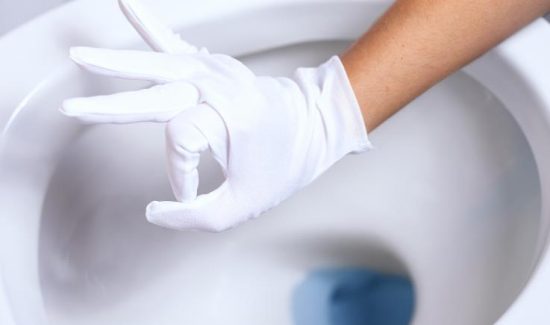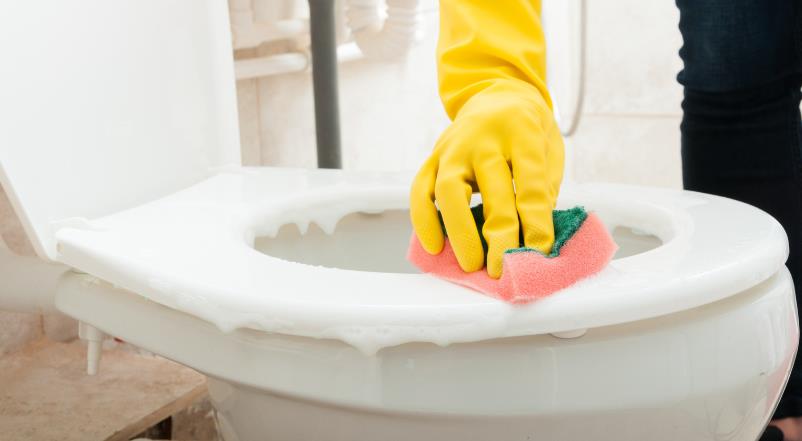Keeping your toilet clean is crucial to maintaining a fresh, clean bathroom. If you use the appropriate tools and follow a few easy steps, it doesn’t have to be a labor-intensive process. In this article, we’ll look at the easiest and most effective method for keeping the toilet clean. In order to keep your home clean and comfortable, you need to learn how to clean a toilet effectively.
When to Clean the Toilet?
Establishing a regular cleaning routine for your toilet is critical to preventing bacteria and stains from accumulating. A once-a-week toilet cleaning is sufficient for most households. However, if your bathroom is heavily used, such as in a large family, or if you frequently entertain guests, you may need to clean it more regularly. In between extensive cleanings, giving the toilet seat and handling a little wipe down every few days is a good idea. Because of the constant touch, these locations may contain bacteria. When you monitor its condition daily, it is easier to determine when the toilet needs a deeper or faster cleaning. If you put off cleaning, it will eventually become more complex and time-consuming. Setting a regular schedule helps ensure that cleaning the toilet is manageable.
How Long It Takes to Clean a Toilet?

Depending on the state of the toilet and the kind of cleaning being done, different toilets require different amounts of time to clean efficiently. Generally, a simple clean that wipes the exterior and scrubbing the bowl takes ten to fifteen minutes. It could take up to 30 minutes if the toilet has been cleaned for a while because you might have to repeat some stages to eliminate more stubborn deposits or stains. Less time can be spent on each cleaning appointment by performing quick maintenance cleans over the week. You can speed up the cleaning procedure by using effective cleaners and efficient tools. The secret is consistency; regularly cleaning the restroom can keep the tasks from taking too long. Remember, the longer dirt and grime sit, the harder they will be to remove.
Tools Required to clean the toilet
- Toilet Brush: A high-quality toilet brush is essential for efficient toilet cleaning. This tool’s firm bristles reach beneath the rim and deep into the bowl to ensure that every area is thoroughly cleaned. Pick a brush with a long handle to avoid touching the contaminated water with your hands. Specific brushes have a holder for sanitized storage. To keep your toilet brush effective and stop the spread of germs, replace it regularly. Another way to reduce cross-contamination is to have a different brush in each restroom.
- Disinfectant Cleaner: Using a disinfectant cleaner is essential to kill bacteria and germs from your toilet’s outside and interior. Choose a cleaner designed primarily to combat the germs commonly present in toilets. This kind of cleaner aids in odor removal and sanitizing. To guarantee adequate disinfection, spray or apply the cleaner as per the directions on the product package. Let it sit for the prescribed time before you clean or wipe it away. Follow all safety guidelines to avoid dangerous fumes or skin irritation.
- Rubber Gloves: When cleaning solutions, gloves protect your hands from pathogens and harsh chemicals. They also stop bacteria from spreading and avoid skin contact with infected surfaces. Ensure the gloves have a firm grip and are long-lasting before handling damp or slick objects. The gloves should be cleaned, rinsed with soapy water, and air-dried before storage. To preserve hygiene, it’s a good idea to keep several pairs of gloves on hand and replace them regularly—store gloves in a cool, dry area to keep them from declining.
- Toilet Bowl Cleaner: A specialized toilet bowl cleaner is designed to stick to the bowl’s edges for maximum cleaning. These cleansers frequently contain natural or chemical acids that dissolve biological waste, lime scale, and stains. To get the most cleaning power, apply the cleaner under the rim and along the bowl’s sides and let it work for a few minutes. After giving the toilet a thorough scrub with your brush, flush to remove any remaining residue or debris. When utilizing cleaners that include chemicals, make sure the space is adequately ventilated. The bowl will remain clean and fresh if a toilet bowl cleaner is used regularly.
- Sponge or Scrubbing Pad: A sponge or scrubbing pad is necessary for cleaning the external surfaces of the toilet. These tools effectively remove splashes and spill around the base and the back of the bathroom, where dust and grime can accumulate. Use a sponge that isn’t abrasive to avoid scratching the finish of your toilet. Disinfect the sponge or pad regularly to keep it clean and practical. Replace these tools often, as they can harbor bacteria over time. Store them in a dry area to prevent mildew growth.
- Pumice Stone (Optional): A pumice stone is beneficial for removing tough mineral deposits and stains that regular brushes and cleaners cannot clear. It helps combat hard water stains inside the bowl. Wet the pumice stone before use to prevent scratching the porcelain surface. Gently rub the stained area until the deposit is gone. Rinse the stone and the toilet well after use. It’s better to store the pumice stone in a dry place to extend its usability.
How to Clean a Toilet Easily?
Applying Toilet Bowl Cleaner
Begin cleaning with a liberal toilet bowl cleanser under the toilet’s rim. This guarantees the cleaner can reach down to cover the bowl. Let the cleanser soak for a few minutes to remove stains, germs, and limescale. This soaking time is essential for the cleaner to properly disinfect and clean. The cleaner’s chemicals work to remove deposits and grime during this period. Find the precise soaking time for optimal results by consulting the manufacturer’s guidelines.
Protecting Yourself with Gloves
Wearing rubber gloves will safeguard your hands while the cleanser is soaking. Wearing these gloves shields your skin from harsh chemicals and shields it from pathogens. Please ensure the gloves are sturdy enough to survive cleaning and fit correctly. Additionally, wearing gloves stops bacteria from spreading to other areas of your house. To keep the gloves clean, wash them with soap and water after each use, thoroughly rinse them, then hang them out to dry.
Scrubbing the Bowl
After the soaking period has passed, clean the bowl’s interior with a toilet brush. Since this area frequently gathers the most dirt, clean beneath the rim to remove any buildup. Ensure every region is cleaned by extending the brush into the bowl and down to the exit hole. The brush’s bristles should be firm enough to remove tough stains without scratching the porcelain. This step is essential to guarantee that the toilet is hygienically clean and to remove the loosened deposits physically.
Flushing to Rinse
Flush the toilet after cleaning to remove the cleaner and any loose particles. Flushing aids in removing any remaining cleaning debris from the bowl. Look for any areas in the bowl that might still require some cleaning. To ensure the toilet is clean, repeat the scrubbing and flushing procedure if needed. When the flush water is clean, most dirt and bacteria are eliminated.
Cleaning External Surfaces
Spray disinfectant cleaner on the external surfaces of the toilet, including the tank, lid, seat, base, and behind the seat. These areas can harbor germs due to frequent contact and should not be neglected. Remember to use a clean cloth or sponge to wipe down these surfaces thoroughly. Pay special attention to high-touch areas such as the flush handle and seat. This step not only sanitizes the toilet but also helps maintain a uniformly clean appearance.
Final Flush and Tool Cleanup

Give the toilet one more flush to ensure everything is spotless. This last flush ensures that the bathroom is clean and ready for use by removing any previous traces of cleaning solution. Make sure your cleaning instruments are thoroughly rinsed under running water after cleaning. Disinfect the brush and cleaning cloth or sponge to prevent them from harboring bacteria. Before storing any tools in a dry, clean location, let them air dry. The tools’ longevity and ability to clean effectively depend on proper tool maintenance.
By following these detailed steps, you ensure that your toilet is visually clean and hygienically maintained. Regular adherence to these procedures will make the process quicker and more effective, contributing to a healthier home environment.
Things to Avoid while cleaning the toilet`
Avoiding a few typical mistakes when cleaning your toilet is essential to guarantee a secure and efficient procedure. First, avoid using harsh or aggressive cleansers. Although they may seem like a quick fix, they can harm your toilet’s porcelain finish by etching or dulling it, increasing the likelihood of recurrent stains. Furthermore, avoid utilizing brushes with metal bristles. These can damage your toilet’s surface, leaving grooves where bacteria may grow and eventually damage the material.
Mixing different cleaners is another hazardous practice; for example, combining bleach and ammonia can release toxic fumes that are dangerous to inhale. Always check the compatibility of cleaning products and follow the manufacturer’s instructions. Furthermore, it’s crucial to pay attention to the cleaning of the brush itself after each use. If the brush is not cleaned and dried properly, it can become a growing ground for bacteria, contaminating your bathroom and spreading to other areas of your home.
Also, be cautious about the amount of cleaner used; large amounts only sometimes improve cleaning performance and can be wasteful and environmentally unfriendly. Last, leave cleaning agents in the toilet bowl as long as they have passed. Prolonged contact with specific substances that cause discoloration or damage to the porcelain may compromise your toilet’s cosmetic and hygienic qualities. By avoiding these frequent blunders, you can keep your bathroom fresh, clean, and safe without risking your health or your fixtures.
FAQs on how to clean a toilet easily
How often should I use chemical cleaners?
Chemical cleaners should be used as needed, depending on the soil level and stains. Less harsh chemicals can be effective and safer for regular maintenance.
What is the best way to remove hard water stains?
A pumice stone is effective for removing hard water stains. Always wet the stone before use to prevent scratching the porcelain.
How do I prevent mold in the toilet?
Keep the bathroom well-ventilated and clean the toilet regularly. Using a disinfectant can also help prevent mold growth.
Is it necessary to clean the toilet brush?
Yes, cleaning the toilet brush after every use is essential. Rinse it clearly and allow it to dry to prevent bacterial growth.

